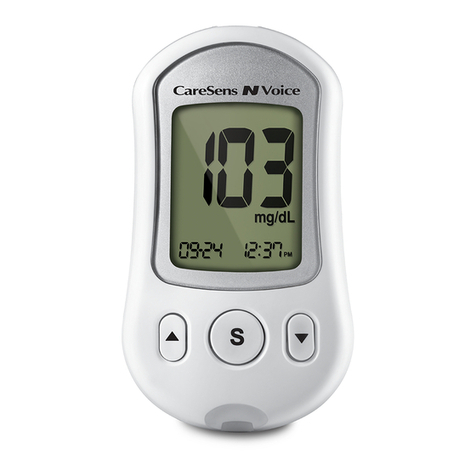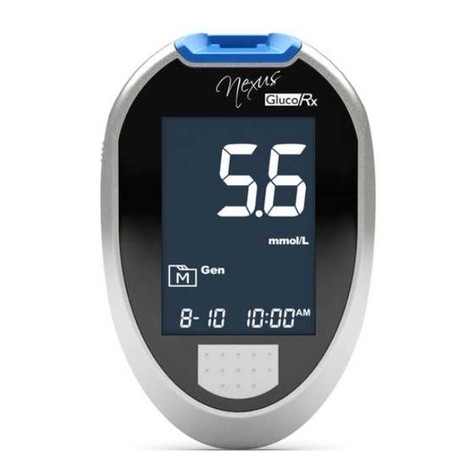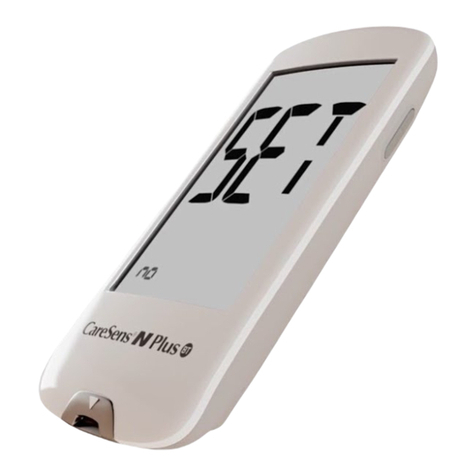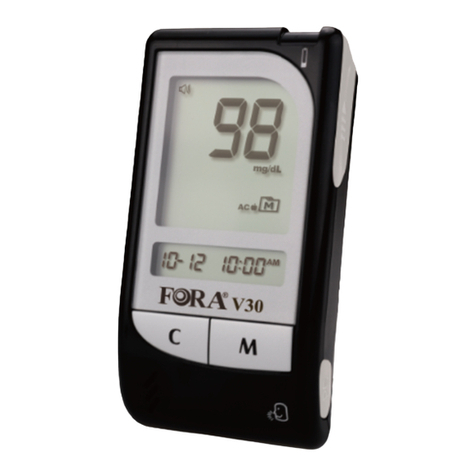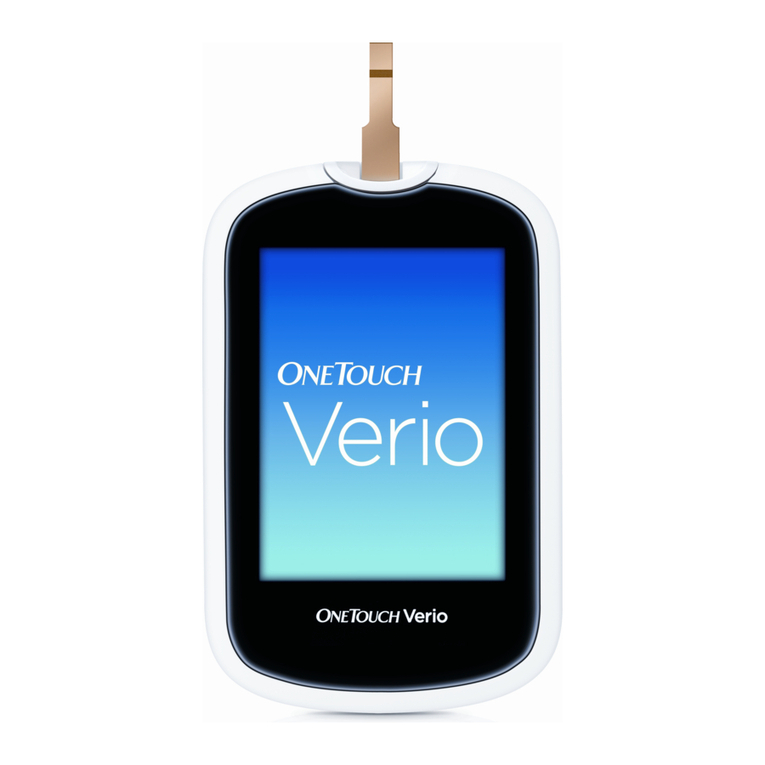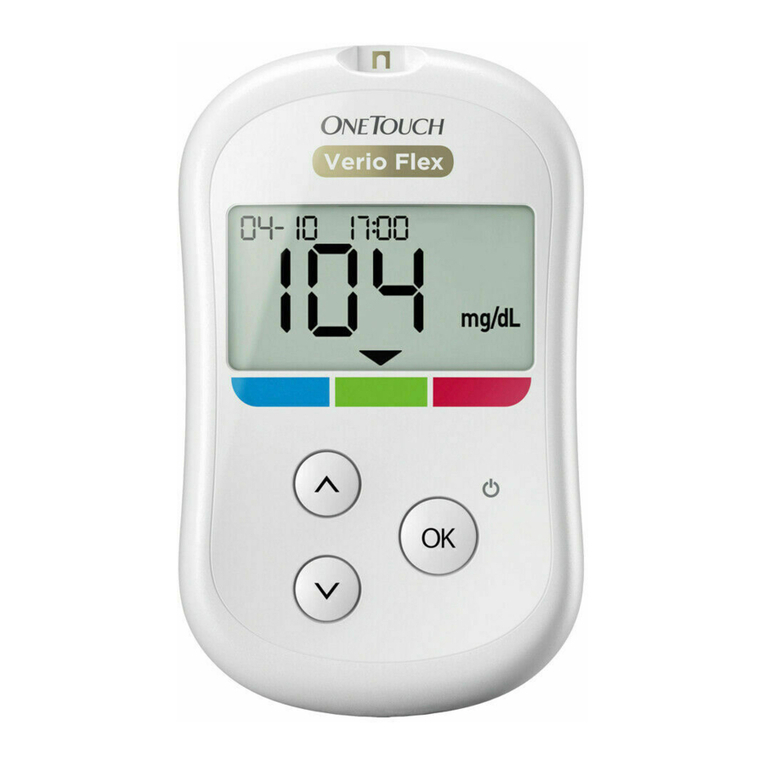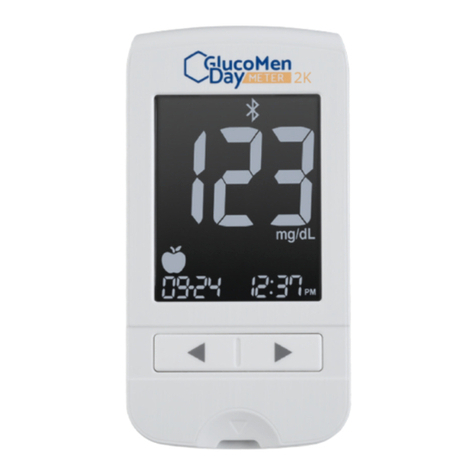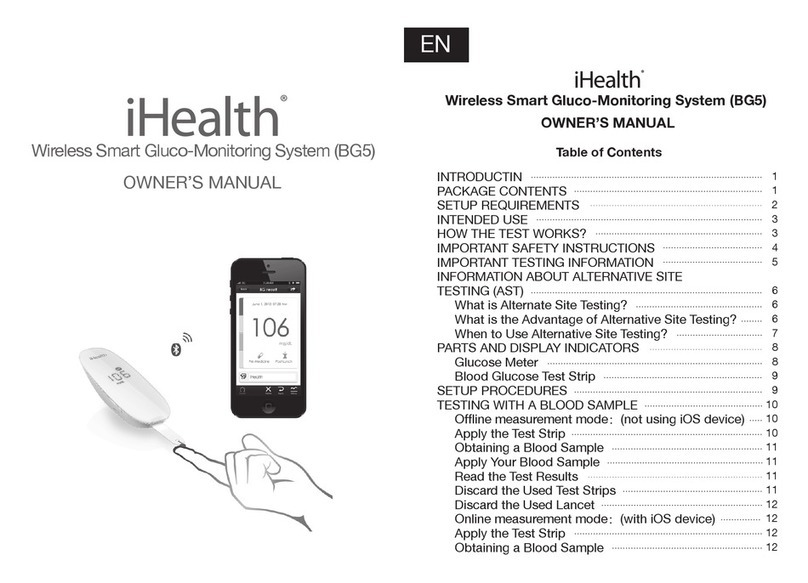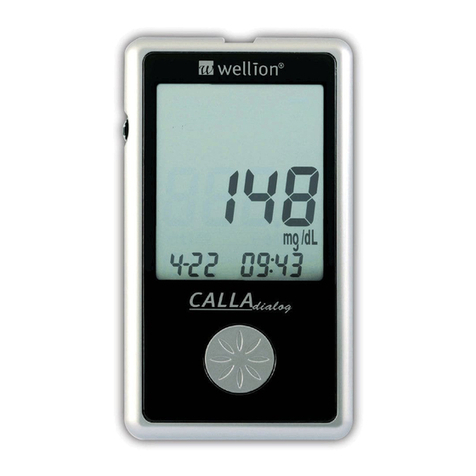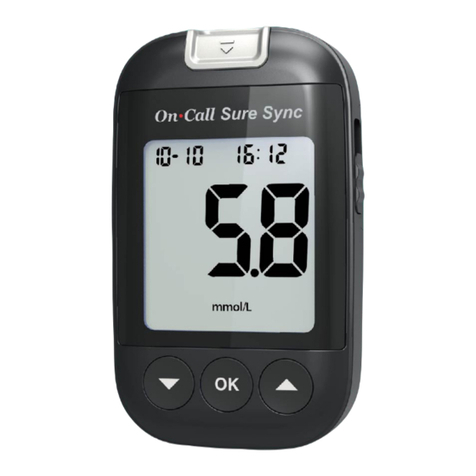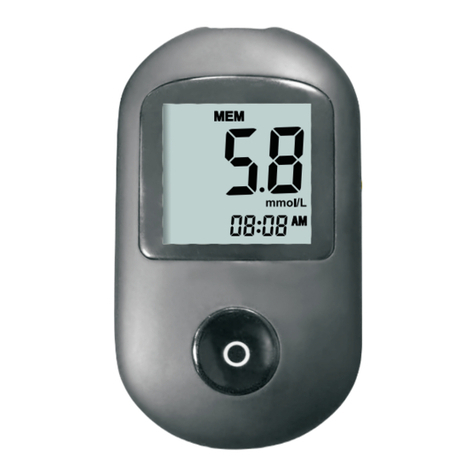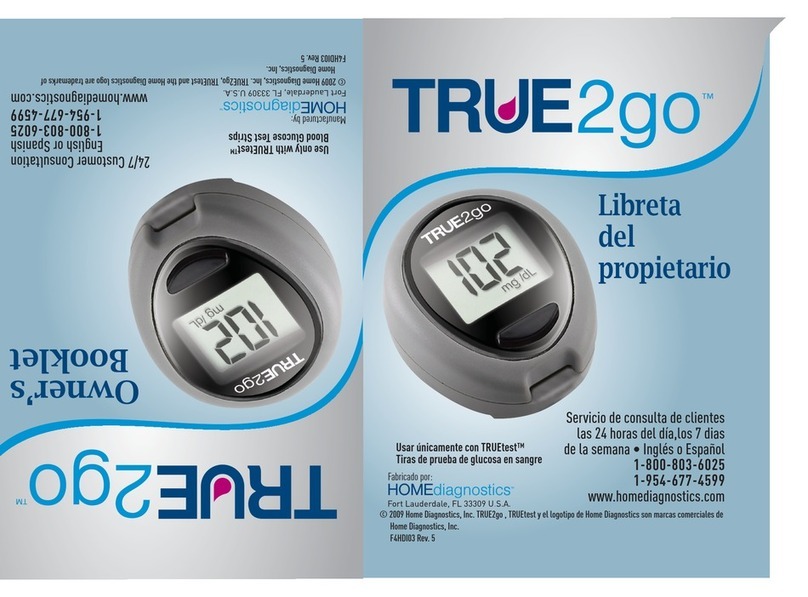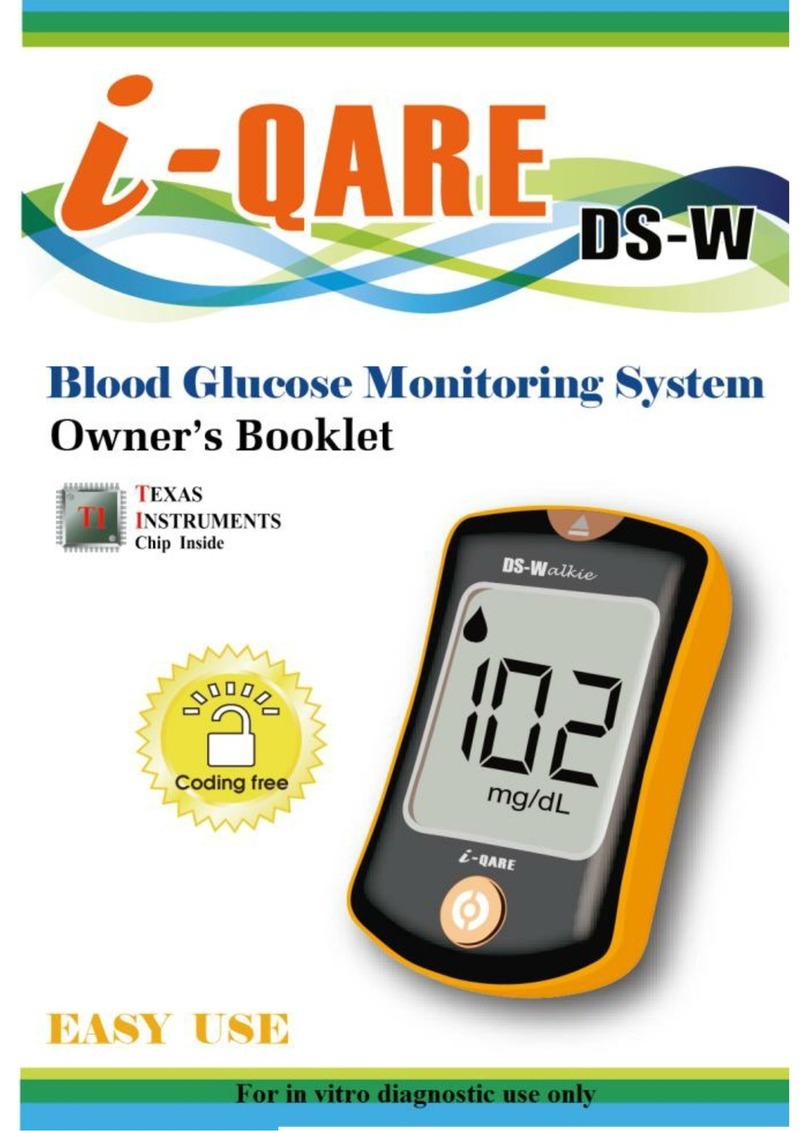SMS SureEdge -4240 User manual

Blood Glucose
Monitoring System
Owner's
Manual
Version 1.0 March 2008
M

Dear System Owner:
This manual contains important information you must know about the
system. Please read it thoroughly and carefully.
The greatest feature of this system is its No-Code function which
alleviates the need to calibrate your meter, allowing you to easily
monitor your blood glucose at home.
Another unique feature is its strip-ejection function, which allows
you to remove the used strip without touching the test strip. This may
prevent any cross-contamination of potentially biohazardous materials.
This meter also provides up to four alarm functions, which alert you to
perform blood glucose test at the desired time. This thoughtful design
helps you routinely check your daily blood glucose on time.

IMPORTANT SAFETY INSTRUCTIONS
READ THIS BEFORE USING
The following basic safety precautions should always be taken.
1. Close supervision is necessary when the device is used by, on, or
near children, handicapped persons or invalids.
2. Use the device only for the intended use described in this manual.
3. Do not use strips and control solutions which are not supplied by
the manufacturer.
4. Do not use device if it is not working properly, or if it has suffered
any damage.
5. Before testing your blood glucose, read all instructions thoroughly
and practice the test. Do all quality control checks as directed and
consult with a diabetes healthcare professional.
KEEP THESE INSTRUCTIONS

TABLE OF CONTENTS
IMPORTANT INFORMATION 06
ABOUT ALTERNATIVE SITE TESTING (AST) 07
GETTING STARTED 09
Intended Use 09
Principle of Measurement 09
Contents of the System 10
Appearance and Key Function of the Meter 11
LCD Display 12
Appearance of the Test Strip 13
PREPARATION BEFORE USE 14
Battery Replacement 14
Setting the Meter and Deleting the Memory 16
Alarm Function 24
BEFORE TESTING 26
Checking with Control Solutions 26
Important Control Solution Information 27
Doing a Control Solution Test 28

5
TESTING YOUR BLOOD 32
Test Procedure 33
Expected Test Results 39
COMPARING METER AND LABORATORY RESULTS 40
USING THE METER MEMORY 42
VIEWING RESULTS ON A PERSONAL COMPUTER 46
TAKING CARE OF YOUR METER AND STRIPS 47
Cleaning 47
Storage 47
PROBLEM-SOLVING GUIDES 50
Special Message 51
Error Message 52
Problem in Operation 53
SPECIFICATIONS 55
SUMMARY OF OPERATION 56

6
IMPORTANT INFORMATION
Severe dehydration and excessive water loss may cause false low
results. If you believe you are suffering from severe dehydration,
consult a healthcare professional immediately.
If you get your blood glucose results lower or higher than usual, and
do not have symptoms, rst repeat the test. If you have symptoms
or continue to get results higher or lower than usual, follow the treat-
ment advice of your healthcare professional.
Apply only capillary whole blood sample to the absorbent hole.
Applying other substances to the absorbent hole will cause
inaccurate results.
If you are experiencing symptoms that are not consistent with your
blood glucose test results and you have followed all instructions
described in this owner’s manual, call your healthcare professional.
Inaccurate results may occur in severely hypotensive individuals or
patients in shock. Inaccurate low results may occur for individuals
experiencing a hyperglycemic-hyperosmolar state, with or without
ketosis. Critically ill patients should not be tested with blood glucose
meters. Please refer to your test strip package insert for additional
important information.
Please refer to your test strip package insert for additional important
information.
2

7
ABOUT ALTERNATIVE SITE TESTING (AST)
Important: There are limitations for doing AST. Please consult
your healthcare professional before you do AST.
What is AST?
Alternative site testing (AST) means that people use parts of the body
other than ngertips to check their blood glucose levels. This system
provides you with the ability to test on the palm, the forearm, the upper
arm, the calf, and the thigh with the equivalent results to ngertip
testing.
What’s the advantage?
Fingertips feel pain more readily because
they are full of nerve endings (receptors).
At other body sites, since nerve endings are
not so condensed, you will not feel as much
pain as at the ngertip.
When to use AST?
Food, medication, illness, stress and
exercise can affect blood glucose levels.
Capillary blood at ngertip reects these
changes faster than capillary blood at other sites. Therefore when
testing blood glucose during or immediately after meal, physical exer-
cise, or any other events, take blood sample from your nger only.
We strongly recommend you do AST ONLY in the following intervals:
In a pre-meal or fasting state (more than 2 hours since the last
meal).
Two hours or more after taking insulin.
Two hours or more after exercise.

8
Do NOT use AST if:
You think your blood glucose is low.
You are unaware of hypoglycemia.
Your AST results do not match the way you feel.
You are testing for hyperglycemia.
Your routine glucose results are often uctuating.
You are pregnant.
How to increase the accuracy?
Stimulating blood perfusion by rubbing the puncture site prior to blood
extraction has a signicant inuence on the glucose value obtained.
Blood from the site without rubbing exhibits a measurably different
glucose concentration than blood from the nger.
Please follow suggestions below before getting a drop of blood:
Rub the puncture site for about 20 seconds before puncturing.
Use a clear cap while setting the lancing device.

9
GETTING STARTED
Intended Use
The system is intended for use outside the body (in vitro diagnostic
use). It should be used only for testing glucose (sugar) and only with
fresh capillary whole blood samples taken from the finger and the
alternative sites including the palm, the forearm, the upper arm, the
calf and the thigh. The system is intended for use in the home and in
clinical settings. It should not be used for the diagnosis of diabetes or
for the testing of newborns.
AST in this system can be used only during steady-state blood glucose
conditions described in the section of “About AST”.
Principle of Measurement
The test is based on the measurement of electrical current generated
by the reaction of glucose with the reagent of the strip. The meter
measures the current and displays the corresponding blood glucose
level. The strength of the current produced by the reaction depends on
the amount of glucose in the blood sample.

10
The System should be used with three main products: the blood glucose meter,
test strips, and a control solution. These products have been designed, tested,
and proven to work together as a system to produce accurate blood glucose test
results. Use only the test strips and Glucose Control Solution
with your meter.
Your system includes:
• Meter • Owner’s Manual
• Sporty carrying case • First Time User’s Guide
• Daily log book • Warranty card
NOTE
Always use the same brand name of test strips and glucose
control solution with the blood glucose meter.
Contents of the System
Please make sure that all products listed above are contained and sealed
in the package before using this system. If you nd any imperfection in
our products, please return the whole system to the place of purchase.
Please note that strips, control solutions, lancets, the lancing device
and the clear cap for AST use are optional. Those are not included in the
standard kit. Please ask your local agent for availability.
WARRANTY
CARD
A
B
C
D
E
Test Strips
(optional)
Lancets
(optional)
Lancing Device
(optional)
Control
Solution
(optional)
Clear Cap
(optional)
M

11
Appearance and Key Function of the Meter
1. TEST SLOT:
is where you insert the test strip. The meter will turn on automatically
2. LCD DISPLAY:
guides you through the test using symbols and simple messages.
3. DATA PORT
located at the side, is for cable connection.
4. STRIP-EJECTION BUTTON:
to remove the used strip from strip slot.
5. SET BUTTON: (Back, below battery compartment)
allows user to set up Year, Month, Day, Hour, Minute, Glucose unit,
Temperature unit, Measurement record erasing, and Alarms.
6. MAIN BUTTON
Into memory recall mode, or waiting strip insert Mode.
7. BATTERY COMPARTMENT (back)
M
1
2
3
4
5
6
7

12
TEST STRIP SYMBOL
Appears when the
meter is turned on.
BLOOD DROP SYMBOL
Flashes when it is ready
to apply the sample.
MEASUREMENT UNIT
Appears with the test result
either in mg/dL or mmol/L.
MEMORY SYMBOL
Appears when you
review the memory
DAY AVERAGE
indicates that the displayed
test result is an average
CTL SYMBOL
Appears when doing a control
test and indicates that the
result will not be stored
in the memory.
LOW BATTERY
SYMBOL
Appears when the
battery power is low.
TEST RESULT AREA
Displays glucose results.
A decimal point appears
when the measurement
is set for mmol/L.
KETONE WARNING
Appears when the
test result is equal or
higher than 240mg/dL
(13.3mmol/L).
LOW-HIGH SYMBOL
They appear with test results
which exceed the reference
range.
ALARM FUNCTION
INDICATOR
Appears when alarms are set.
Four alarms can be set in this
meter.
LCD Display
.
DATE
TIME
high
low

13
Appearance of the Test Strip
This system measures the amount of sugar (glucose) in whole blood.
Blood is applied to the absorbent hole of the test strip and is automati-
cally drawn into the reaction cell where the reaction takes place.
The test strip consists of the following parts:
Contact Bars
Insert this end of the test strip into the meter.
Push it in rmly until it will go no further.
*Make sure white side is facing up.
Test Strip Handle
Hold this part to insert the test strip into the slot.
Conrmation Window
This is where you conrm if enough blood has been
applied to the absorbent hole of the strip.
Absorbent Hole
Apply a drop of blood here,
The blood will be drawn automatically.

14
M
PREPARATION BEFORE USE
Battery Replacement
Your meter comes with one 3V CR2032 Lithium battery. The meter
will alert you when the power is getting low by displaying two different
messages:
1. When symbol is displayed on the
screen: the meter is functional and the
result remains accurate, but it is time to
change the battery.
2. When symbol, low and E-b symbol is on
the display, the battery can not provide
enough power to do a test. You must
change the battery immediately.
PLEASE NOTE
Replacing the battery within 5 minutes does not affect the set-
tings. Therefore, the settings do not need to be updated when
the battery is changed.
Batteries might leak chemicals if not used for a long time.
Remove the battery if you are not going to use the device for
an extended period (i.e., 3 months or more).
Do not use the used battery. Use only the new one in required
size and type.
M

15
STEP1 Press the buckle on the battery cover and lift up to remove
cover.
STEP2 Remove the old battery and replace with one 3V CR2032
Lithium battery.
STEP3 Close the battery cover.
To replace the battery, make sure that the meter is turned off.
WARNING
As with all small batteries, the batteries should be kept away from
small children. If they are swallowed, promptly see a doctor for
help.
STEP 2 STEP 3
STEP 1

16
M
Setting the Meter and Deleting the Memory
Your meter comes with the time, date, unit of measurement, unit of
temperature preset, memory deletion and alarm function setting. If you
need to set these parameters, please follow the steps below.
Start with the meter off. Then press
the set button located in the battery
compartment. The meter is now in the
setting mode.
STEP 1. Set the Year
After pressing the set button, the year,
a blinking number, will be shown on the
screen. Press and release the M button to
plus one year. You can also keep pushing
down the M button to proceed faster.
When the correct year is displayed on
the screen, press the set button and then
a flashing number, which stands for the
month, is shown.
STEP 2. Set the Month
Press and release the M button until you
see the correct month. To move faster,
keep pushing the M button down. When
the desired month is displayed, press the
set button and then the day will ash.
M

17
M
M
M
M
STEP 3. Set the Day
Press and release the M button until you
see the correct day. To move faster, keep
pushing the M button down. When the
desired day is displayed, press the set
button and then 12h or 24h will be shown
on the screen.
STEP 4. Select the 12h or 24h
Press and release the M button to select 12h or 24h. If you select 12h,
AM and PM will be shown together with time. An example is shown
below.
If you select 24h, format of time will be from 00:00 to 23:59 without AM
and PM. An example is shown below.
After nishing setting 12h or 24h, press the set button and then the
hour will ash on the screen.
10 o’clock
in the morning
10 o’clock
in the evening
10 o’clock
in the morning
10 o’clock
in the evening
P
M

18
M
M
M
STEP 5. Set the Hour
Press and release the M button until you
see the correct hour on the screen. To
move faster, keep pushing the M button
down. When the desired hour is displayed
on the screen, press the set button and
then the minute will ash.
STEP 6. Set the Minutes
Press and release the M button to
advance one minute. To move faster,
keep pushing the M button down. When
the desired minute is displayed, press
the set button and then the current unit of
measurement will ash.
STEP 7 Select mg/dL or mmol/L
Press and release the M button to select the unit of measurement you
want to use until it is shown on the screen. Press the set button and
the current unit of temperature will ash.
The milligram per deciliter (mg/dL) is the standard unit in the
United States. The mmol/L is the standard unit in Canada. Use of
the wrong unit of measure may cause you to misinterpret your
blood glucose level, and may lead to incorrect treatment.
M
M

19
STEP 8. Select °C or °F
Press and release the M button to select the unit of temperature.
Press the set button to go to the next step for “Delete Memory”.
The time, date, unit of measurement and unit of temperature can
ONLY be changed in the setting mode. Therefore, when you per-
form a glucose testing, those parameters are not possible to be
changed.
The meter cannot automatically update daylight saving time. You
have to manually adjust the time in the meter according to the
procedures. Please make sure the meter matches the time zone
and adjust the daylight saving time data if required.
Your meter displays 7-, 14-, 21-, 28-, 60- and 90-day averages
which you can access from the meter memory. These averages
are calculated from results obtained during the 7-, 14-, 21-, 28-,
60- and 90-day preceding the current date and time settings.
When the date and time are changed, the 7-, 14-, 21-, 28-, 60-
and 90-day averages may change.
While the meter is in the setting mode, it will turn off automatically
without any action in three minutes.
PLEASE NOTE
M
M
M
°F °F °F

20
M
M
M
M
STEP 9. Delete Memory
“dEL” and “ ” and flashing Yes/no is displayed on the screen. If
you do NOT want to delete memory, press the M button to select “no”
and then press set button to go to step 10. If you’d like to delete ALL
memory, press M button to select “yes”. Then press set button to
delete All memory. ”OK” is displayed in the meter, which means that
all data stored is deleted. Go to step 10.
STEP 10. Select and Set Alarm Function
The meter provides four alarms. You are able to set four different
alarm times a day. “On” or “OFF” and “ ” are displayed on the
screen. Press the M button to turn on or turn off Alarm 1.
Alarm 1 setting
If you press the M button to select “OFF”, then press the set button to
go to set Alarm 2.
Table of contents
